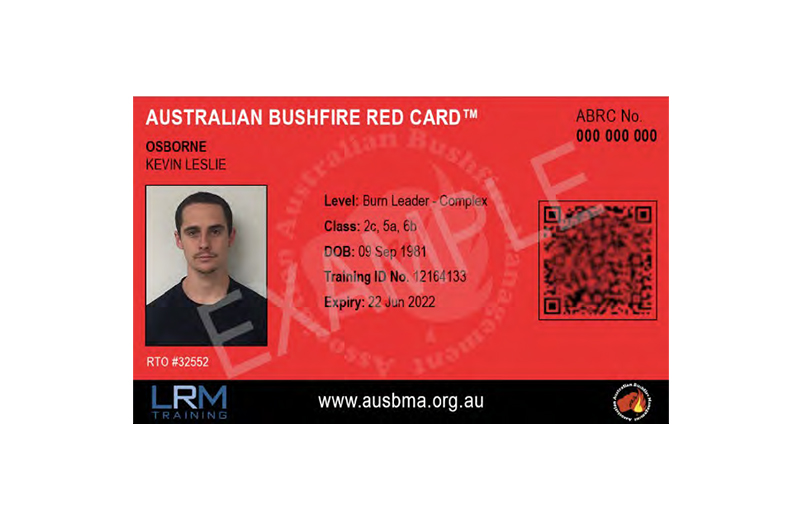In Australia, many private, non-government and government organisations undertake public safety training for bushfire mitigation and response in accordance with the Australian Qualifications Framework (AQF). This training is often tailored for and undertaken with organisation-specific aims and objectives and can differ between organisations and state and territory jurisdictions.1
Along with this diversity of training, private sector engagement with local, state and territory organisations has been challenging. This is because there is no consistent standard by which to measure an individual’s safety training or their competency, nor the due diligence of the training delivery business. Rather, businesses were leveraging off the standards of the states and territories that differed greatly and, in most cases, were not relevant.
A new national training framework has been endorsed by the Australian Bushfire Management Association (ABMA) in consultation with the sector. The framework provides a standardised training and competency benchmark that will demonstrate an individual’s qualifications, competency and fitness for work in roles within the bushfire management industry.
The new minimum national standard
In April 2021, the ABMA rolled out the National Training and Competency Framework2 for the Australian Bushfire Red Card™ (ABRC).3 The card was specifically designed to provide:
- a standardised national training framework based on industry standards and expectations
- role-specific levels and classifications aligned to skill sets endorsed by the ABMA
- a defined career pathway using roles within the bushfire management industry
- transparency for competency and fitness for work using the Red Card that will be replicated as a digital card
- verification of competency to employers, incident management teams and stakeholders via unique QR codes on the Red Card
- an annual verification of competency and renewal of red cards prior to the fire season
- work health safety due diligence for training, competency and fitness for work
- recognition by local councils, fire agencies and stakeholders to streamline procurement processes
- alignment with the US National Wildfire Coordinating Group (NWCG - USA) standards for international resource sharing.
Training delivery and assessment of units of competency are all-inclusive within the framework and are attained through authorised Registered Training Organisations (RTO) with the AQF training component currently within their respective scope of registration.
The ABMA ensures integrity, security and ongoing governance and compliance of the ABRC by endorsing LRM Training Services (RTO#32552) as the exclusive ABRC issuing organisation. This is in accordance with the licensed Red Card trademark.

Australian Bushfire Red Card. Image: Australian Bushfire Management Association
NWCG – USA alignment
The new framework is mapped to the NWCG - US standards for wildfire training (see Table 1). This was achieved in consultation with the US National Wildfire Suppression Association to enable efficient and transparent resource sharing on an international scale. A priority was training and competency levels of personnel to permit assimilation of firefighting teams.
The framework will be presented at the NWCG - US for formal recognition to enable personnel from Australia to seamlessly operate on firegrounds in America as quickly as possible and to minimise possible lag time in training gaps.
Table 1: Alignment of the NWCG – US Standard to the ABRC
| NWCG Standard | National Training and Competency Framework |
| Firefighter Type 2 (FFT2) | Bushfire Fighter (Level 2 - BF) |
| Firefighter Type 1 (FFT1) | Advanced Fighter (Level 3 - AFF) |
| Single Resource Boss Crew (CRWB) | Crew Leader (Level 4 - CL) |
| Single Resource Boss Heavy Equipment (HEQB) | Crew Leader (Level 4 - CL) with Class 4a |
| Single Resource Boss Engine (ENGB) | Crew Leader (Level 4 - CL) with Class 2f |
| Basic Faller (FAL3) | Bushfire Fighter (Level 2 - BF) with Class 2d |
| Intermediate Faller (FAL2) | Advanced Fighter (Level 3 - AFF) with Class 3a |
Source: NSWA Crosswalk to NWCG mapping assessment October 2021
Training delivery and assessment options
RTOs holding the specific units of competency may deliver and assess the training. Applicants who have extensive experience as well as knowledge and skills and provide evidence to undertake roles within the ABRC framework may apply for recognition of prior learning status for competency units. Others with extensive experience who are unable to provide evidence may undertake physical verification of competency. This is an assessment of physical performance of a competency. Applicants attaining all competency units may apply to the ABMA for a Red Card.
The Training and Competency Framework eliminates ambiguity in the training and competency assessment of private sector fire management personnel. It provides a national and standardised approach to training, competency and fitness for work. It also brings clarity to businesses to fulfil obligations under state or territory work health safety legislation relating to training and supervision in workplaces.
The Red Card verifies competencies and gives transparency and governance to prove due diligence is undertaken. Red Card holders are qualified, competent to current requirements, fit for work and can effectively operate on firegrounds.
This initiative improves safety for personnel and teams and shows work health safety compliance for businesses. It provides fire services agencies and their stakeholders with the confidence to work with private sector bushfire agencies within Australia as well as overseas. Through the National Training and Competency Framework and the Red Card, the private sector strengthens Australia’s state and territory capacity and capability to improve bushfire resilience.


